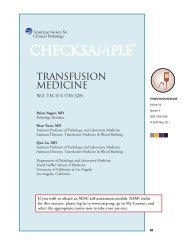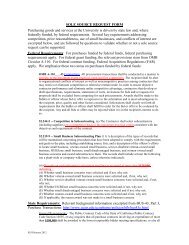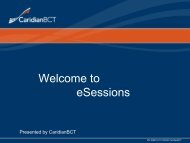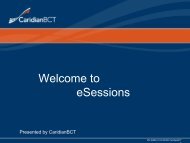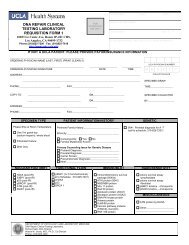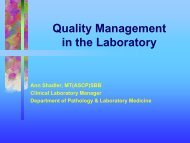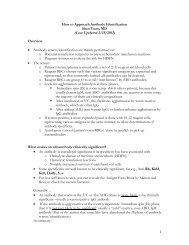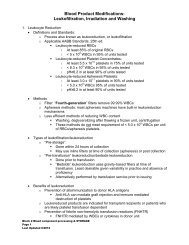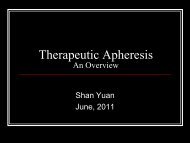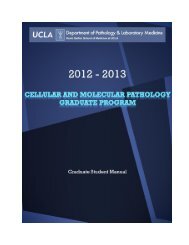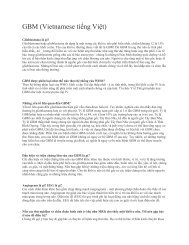Pre-Transfusion Testing - the UCLA Department of Pathology ...
Pre-Transfusion Testing - the UCLA Department of Pathology ...
Pre-Transfusion Testing - the UCLA Department of Pathology ...
You also want an ePaper? Increase the reach of your titles
YUMPU automatically turns print PDFs into web optimized ePapers that Google loves.
<strong>Pre</strong>-<strong>Transfusion</strong> <strong>Testing</strong><br />
Alyssa Ziman, MD<br />
<strong>UCLA</strong> Medical Center
<strong>Pre</strong>-<strong>Transfusion</strong> <strong>Testing</strong><br />
• Purpose<br />
– Avoid risks to donor and recipient<br />
– Meet product specifications<br />
• Consist <strong>of</strong> both donor and patient testing.<br />
– Donor testing and residual risk <strong>of</strong> infection<br />
– Patient testing
Donor <strong>Pre</strong>-<strong>Transfusion</strong> Evaluation<br />
• Donor medical history and risk factor<br />
assessment<br />
• Infectious disease testing<br />
• ABO and Rh typing<br />
• Test for antibodies to red cell antigens<br />
• Capturing post donation information
Donor Infectious Disease <strong>Testing</strong><br />
• Hepatitis B, sAg and anti-core antibody<br />
• Hepatitis C antibody<br />
• HIV 1 and 2 antibodies<br />
• HTLV 1 and 2 antibodies<br />
• Serologic Test for Syphilis<br />
• Nucleic Acid <strong>Testing</strong> (NAT) for HIV, HCV and<br />
WNV<br />
• Detection <strong>of</strong> Bacteria in platelet products<br />
• CMV antibody for select recipients
Routine Donor <strong>Testing</strong> Algorithm<br />
Blood Screening<br />
Assays<br />
Confirmatory<br />
Assays<br />
Supplemental<br />
Assays<br />
Referral <strong>Testing</strong><br />
Anti-HCV EIA<br />
HIV-1/HCV NAT Discrimination (Chiron)<br />
RIBA HCV 3.0 SIA<br />
Ab to HCV Strip Immunoblot Assay (Chiron)<br />
NA<br />
Anti-HIV-1/2 EIA<br />
Plus O<br />
Licensed Anti-HIV-1<br />
IFA<br />
Flourognost<br />
Anti-HIV-2 EIA<br />
Genetic Systems, Inc.<br />
•If Non-reactive, no fur<strong>the</strong>r<br />
testing.<br />
•If Reactive, perform HIV-2<br />
EIA WB.<br />
Anti-HIV-2 WB<br />
California<br />
<strong>Department</strong> <strong>of</strong> Health<br />
Services<br />
No fur<strong>the</strong>r testing.<br />
Anti-HTLV-I/II EIA<br />
NA<br />
Alt Manufacturer<br />
HTLV-I/II EIA<br />
Abbott<br />
•If Non-reactive, no fur<strong>the</strong>r<br />
testing.<br />
•If Reactive, sample sent for<br />
referral testing.<br />
EIA/IFA <strong>Testing</strong><br />
California<br />
<strong>Department</strong> <strong>of</strong> Health<br />
Services<br />
No fur<strong>the</strong>r testing.
Routine Donor <strong>Testing</strong> Algorithm<br />
Blood Screening<br />
Assays<br />
Confirmatory<br />
Assays<br />
Supplemental<br />
Assays<br />
Referral <strong>Testing</strong><br />
Anti-HBC EIA NA NA NA<br />
HBsAG ChLIA<br />
HBsAG Confirmatory Neutralization ChLIA (Abbott Prism)<br />
HBC ChLIA (Abbott Prism)<br />
PCR Roche (Referral <strong>Testing</strong>)<br />
NAT HIV-1/HCV<br />
NAT HIV-1/HCV<br />
Discrimination<br />
(Chiron)<br />
No fur<strong>the</strong>r testing<br />
NA<br />
NA<br />
NAT WNV<br />
NA<br />
NA<br />
WNV Panel<br />
Antibody (IgM/IgG)<br />
ELISA<br />
(Sonora Quest)<br />
No fur<strong>the</strong>r testing.
Routine Donor <strong>Testing</strong> Algorithm<br />
Blood Screening<br />
Assays<br />
Confirmatory<br />
Assays<br />
Supplemental<br />
Assays<br />
Referral <strong>Testing</strong><br />
Syphilis<br />
(Olympus PK-TP)<br />
Syphilis G EIA<br />
(CaptiaI)<br />
•If negative, no fur<strong>the</strong>r<br />
testing.<br />
•If positive, supplemental<br />
assay<br />
performed.<br />
RPR/Quantitative<br />
RPR<br />
(Becton Dickinson)<br />
•If negative, no fur<strong>the</strong>r<br />
testing.<br />
•If positive, RPR titer<br />
performed.<br />
NA<br />
T. cruzi Ab EIA<br />
T. cruzi Antibody<br />
RIPA<br />
(Quest Diagnostics Inc.<br />
Nichols Institute)<br />
NA<br />
NA<br />
•If positive, no fur<strong>the</strong>r<br />
testing.<br />
•If NOT positive, sample<br />
sent for Leishmania<br />
Antibody IFA (Focus<br />
Diagnostics)<br />
No fur<strong>the</strong>r testing.
Estimates <strong>of</strong> Known Viral Infectious<br />
Disease Risks <strong>of</strong> <strong>Transfusion</strong><br />
Virus<br />
Risk per Unit<br />
<strong>Transfusion</strong><br />
Transmission<br />
Rate<br />
Window<br />
Period<br />
(mean)<br />
HIV 1&2 1:2,135,000 90% 11 days<br />
HCV 1:1,935,000 90% 10 days<br />
HBV 1:205,000 70% 59 days<br />
HTLV 1:3,000,000 30% 51 days<br />
WNV 1:350,000 Unknown 11- 13 days<br />
Parvo B19 1:40,000 to 3,000 Low -<br />
Hepatitis A/E 1:1,000,000 Low -<br />
<strong>Transfusion</strong>: 2002; 42: 975-979, N Engl J Med 2005;353:451-9.
Risk<br />
Decreasing<br />
Risk<br />
Increasing<br />
Death<br />
from<br />
lightening<br />
Death<br />
by<br />
murder<br />
Estimated<br />
risk per unit<br />
transfused <strong>of</strong><br />
HIV/HCV<br />
Fatal<br />
plane<br />
crash<br />
Fatal<br />
auto<br />
accident<br />
Fatal,<br />
unexpected<br />
drug<br />
reaction in<br />
hospital<br />
Goodnough LT, et al. NEJM 30(6) (<strong>Transfusion</strong> risks), Lazrou J. et al., JAMA 279(15)<br />
(Adverse drug reactions), Luadan L. “The Book <strong>of</strong> Risks,” John Wiley, 1994.
Estimates <strong>of</strong> Known NON-Viral<br />
Infectious Disease Risks <strong>of</strong><br />
<strong>Transfusion</strong><br />
Disease Agent Screening/<strong>Testing</strong><br />
Risk per Unit<br />
<strong>Transfusion</strong><br />
Syphilis<br />
T. pallidum<br />
Serological assays<br />
(Est. 1938; Req. 1958)<br />
No reported cases<br />
since 1968<br />
Malaria Plasmodium Donor screening/deferral 1: 4,000,000<br />
Chagas<br />
Disease<br />
T. cruzi<br />
Serologic Assay<br />
approved by FDA, not<br />
yet mandated.<br />
(Parasite reduction in<br />
endemic areas.)<br />
1:2,000 to<br />
1:25,000
Potential or Theoretical Threats<br />
• Transmissible Spongiform Encephalopathies<br />
• CJD, vCJD<br />
• TTV, SEN-V and HGV<br />
• Human Herpes Virus 6 and 8<br />
• Tick-borne Diseases<br />
• O<strong>the</strong>r Parasitic Diseases<br />
• O<strong>the</strong>r known or unknown viruses
Patient <strong>Pre</strong>-<strong>Transfusion</strong> <strong>Testing</strong><br />
• Patient identification<br />
• Sample identification<br />
• Patient History Review<br />
• Serologic <strong>Testing</strong><br />
– ABO, Rh type<br />
– Antibody screen<br />
• Antibody identification panel<br />
• Compatibility <strong>Testing</strong>
Specimen Requirements<br />
LABELING<br />
– Patient positively identified – 2 unique identifiers<br />
– Specimen and paperwork appropriately labeled.<br />
– Must have phlebotomist’s initials & date <strong>of</strong> <strong>the</strong> draw<br />
VOLUME<br />
– Neonates: 2X 2 ml pink top EDTA BD tubes<br />
– Pediatric/adult patients: 6 ml pink top EDTA<br />
LIFESPAN<br />
– Usually, specimen can only be used within 3 days <strong>of</strong><br />
collection.<br />
– Exceptions:<br />
1. Neonates (
Common Blood Bank Orders<br />
HOLD CLOT: RBC need is unknown. Specimen is held for 3<br />
days “just in case”. No testing done unless requested.<br />
TYPE AND SCREEN: RBC need is possible. Specimen typed<br />
for ABO-Rh and screened for RBC antibodies.<br />
TYPE AND CROSSMATCH: RBC need likely or definite. T&S<br />
performed. Requested # RBCs crossmatched and reserved.<br />
– If pt >4mo until <strong>the</strong> specimen used for testing is 3 days old.<br />
– If pt
Turn-Around-Times<br />
ROUTINE<br />
– TYPE AND SCREEN<br />
• ABO-Rh: 15 minutes<br />
• Antibody Screen: 60 minutes<br />
– CROSSMATCH<br />
• ~ 15 minutes.<br />
• Longer if patient has antibodies.<br />
STAT<br />
– Uncrossmatched O-Neg RBCs: 10 minutes<br />
– STAT blood type: 5 minutes<br />
– Uncrossmatched type specific RBCs: 15 minutes<br />
– STAT type and screen: 60 minutes
Check Type<br />
• Method for verification <strong>of</strong> blood type prior to type-specific RBC<br />
transfusion<br />
– Errors in patient ID/specimen labeling and/or initiating a blood<br />
transfusion are 1:15,000 to 1:30,000<br />
– Comparison <strong>of</strong> current specimen blood type to historical type or type<br />
based on second independently drawn specimen<br />
• <strong>UCLA</strong> Policy: Second independently drawn blood type sample on<br />
previously untyped non-group O patients who require transfusion<br />
or are likely to require transfusion<br />
– Required<br />
• Non-group O patients<br />
• All patients admitted to L&D, OR, ICU<br />
– Exempt<br />
• Trauma patients with dual banding system<br />
• Outpatient clinic
Patient <strong>Testing</strong>:<br />
Check Type<br />
Initial Specimen<br />
Check Type<br />
3 rd Specimen<br />
w111-22-33 7<br />
028/w111-22-33 7<br />
SMITH, ROSA<br />
F 65 01/01/1944<br />
• Two patients on beds in<br />
hallway with number above<br />
bed<br />
• RN drew patients’<br />
specimens based on<br />
location<br />
• Did not check patient ID<br />
• Did not label specimens<br />
at bedside
ABO & Rh Compatibility<br />
Blood<br />
Type<br />
Antigens<br />
<strong>of</strong> RBCs<br />
Antibodies in<br />
Plasma<br />
Patient can<br />
receive RBCs<br />
<strong>of</strong> group….<br />
Patient can<br />
receive<br />
plasma <strong>of</strong><br />
group…<br />
O No A or B Anti-A, Anti-B O only O, A, B, AB<br />
A A Anti-B A, O A, AB<br />
B B Anti-A B, O B, AB<br />
AB A and B none AB, A, B, O AB only<br />
Rh pos D None Rh pos or neg<br />
Rh neg No D None Rh neg*<br />
* Women <strong>of</strong> child bearing age and patients with allo-anti-D
Gel IgG<br />
Type & Antibody Screen<br />
ABO-Rh<br />
cells<br />
Anti-A Anti-B Anti-D A1 cells B cells<br />
D<br />
O<br />
N<br />
O<br />
R<br />
Rh Kell Duffy Kidd Lewis P MNS<br />
D C c E e K k Fy a Fy b Jk a Jk b Le a Le b P 1 M N S s<br />
1 + + 0 0 + + + 0 + + 0 0 + + + 0 + + 1<br />
2 + 0 + + 0 0 + + 0 + + + 0 + + + 0 + 2<br />
• Antibody Screen/Indirect antiglobulin test (IAT): Detects in-vitro<br />
binding <strong>of</strong> antibody and RBCs by using AHG.
Indirect Antibody Screen (IAT)
RBC Agglutination<br />
& Grading<br />
4+ 3+ 2+ 1+ 0 0
Application <strong>of</strong> <strong>the</strong> IAT<br />
• RBC antibody screen and identification<br />
• Weak D testing<br />
• Antibody titration<br />
• IgG Crossmatching<br />
• Typing <strong>of</strong> erythrocytes antigens
Causes <strong>of</strong> False Negative IAT<br />
• Failure to wash RBCs adequately<br />
• Delay in adding AHG reagent or expired AHG<br />
reagent<br />
• Too little serum added/too much reagent<br />
RBCs added<br />
• Under- centrifugation<br />
• Improper incubation temperature or time
Causes <strong>of</strong> False Positive IAT<br />
• Sensitized patient RBCs (positive DAT with<br />
allo or auto antibodies)<br />
• Contamination <strong>of</strong> saline with materials that<br />
can cause spontaneous aggregation <strong>of</strong> RBCs<br />
( eg, colloidal silica from glass bottles)<br />
• Over centrifugation<br />
• Improper AHG reagent
Gel IgG<br />
Type & Antibody Screen<br />
ABO-Rh<br />
cells<br />
Anti-A Anti-B Anti-D A1 cells B cells<br />
O pos 0 0 4+ 4+ 4+<br />
D<br />
O<br />
N<br />
O<br />
R<br />
Rh Kell Duffy Kidd Lewis P MNS<br />
D C c E e K k Fy a Fy b Jk a Jk b Le a Le b P 1 M N S s<br />
1 + + 0 0 + + + 0 + + 0 0 + + + 0 + + 1 2+<br />
2 + 0 + + 0 0 + + 0 + + + 0 + + + 0 + 2 3+
Gel IgG<br />
Antibody Identification Panel<br />
D<br />
O<br />
N<br />
O<br />
R<br />
Rh Kell Duffy Kidd Lewis P MNS<br />
D C E c e K k Fy a Fy b Jk a Jk b Le a Le b P 1 M N S s<br />
1 + + 0 0 + 0 + 0 + + + 0 + + 0 + 0 + 1<br />
2 + + 0 0 + + + + 0 + 0 0 + + + 0 + 0 2<br />
3 + 0 + + 0 0 + 0 + 0 + + 0 0 + + 0 + 3<br />
4 0 + 0 + + 0 + 0 + 0 + 0 + + + + + + 4<br />
5 0 + + + + 0 + 0 + 0 + 0 + + 0 + 0 + 5<br />
6 0 0 0 + + + + + 0 + 0 0 + 0 + 0 + + 6<br />
7 0 0 0 + + 0 + + + + + + 0 + + + + 0 7<br />
8 + 0 0 + + 0 + 0 0 0 0 0 0 + + 0 0 + 8<br />
AC<br />
AC
Gel IgG<br />
Antibody Identification Panel<br />
D<br />
O<br />
N<br />
O<br />
R<br />
Rh Kell Duffy Kidd Lewis P MNS<br />
D C E c e K k Fy a Fy b Jk a Jk b Le a Le b P 1 M N S s<br />
1 + + 0 0 + 0 + 0 + + + 0 + + 0 + 0 + 1 0<br />
2 + + 0 0 + + + + 0 + 0 0 + + + 0 + 0 2 2+<br />
3 + 0 + + 0 0 + 0 + 0 + + 0 0 + + 0 + 3 3+<br />
4 0 + 0 + + 0 + 0 + 0 + 0 + + + + + + 4 0<br />
5 0 + + + + 0 + 0 + 0 + 0 + + 0 + 0 + 5 3+<br />
6 0 0 0 + + + + + 0 + 0 0 + 0 + 0 + + 6 2+<br />
7 0 0 0 + + 0 + + + + + + 0 + + + + 0 7 0<br />
8 + 0 0 + + 0 + 0 0 0 0 0 0 + + 0 0 + 8 0<br />
AC AC 1+<br />
DAT: PS = 0/0 Ct = 0/0
Antigen Frequencies within<br />
Caucasian Donor Populations<br />
Rh System Kell Duffy Kidd MNSs<br />
Ab D C c E e f V Cw K k Kp a Kp b Js a Js b Fy a Fy b Jk a Jk b S s<br />
%<br />
Ag=<br />
unit<br />
15 30 20 70 2 35 99 98 91 0.2 99 0.1 99 0.1 35 17 23 26 50 10<br />
• When anti-E and anti-K are detected, E and K – RBCs units<br />
are required, 63% <strong>of</strong> donors are E and K antigen negative.
IAT for IgG Crossmatch<br />
• Patient’s plasma is incubated with donor<br />
RBCs at 37 C for a period <strong>of</strong> time, <strong>the</strong>n<br />
centrifuged and examined for hemolysis or<br />
agglutination<br />
• Wash 3-4 times to remove all unbound free<br />
serum globulins<br />
• Add polyclonal antihuman globulin<br />
• Observe agglutination formation
Direct Antiglobulin Test (DAT)<br />
• Detects antibodies bound to<br />
erythrocytes in vivo.
Application <strong>of</strong> <strong>the</strong> DAT<br />
• Hemolytic transfusion reactions workup<br />
(acute or delayed) – post transfusion blood<br />
sample<br />
• Hemolytic disease <strong>of</strong> <strong>the</strong> fetus/newborn –<br />
cord blood or newborn blood sample<br />
• Investigation <strong>of</strong> autoantibodies (for possible<br />
autoimmune hemolytic anemia)<br />
• Medication induced antibody or complement<br />
binding
LW<br />
Gel IgG<br />
Eluate<br />
D<br />
O<br />
N<br />
O<br />
R<br />
Rh Kell Duffy Kidd Lewis P MNS<br />
D C E c e K k Fy a Fy b Jk a Jk b Le a Le b P 1 M N S s<br />
1 + + + 0 + 0 + + + + + 0 + + + 0 0 + = 4+<br />
2 + + 0 0 + 0 + 0 0 + 0 0 + + + + 0 + = 4+<br />
3 + 0 0 + 0 0 + 0 + 0 + + 0 0 0 + 0 + = 4+<br />
4 0 + 0 + + + + + 0 0 + 0 + + + 0 + 0 = 4+<br />
5 0 0 + + + 0 + 0 + 0 + 0 + + 0 + 0 + = 4+<br />
6 0 0 0 + + + + + 0 + 0 0 + 0 + 0 + + = 4+<br />
7 0 0 0 + + 0 + 0 + + + + 0 + + + 0 0 = 4+<br />
8 0 0 0 + + 0 + + + 0 0 0 0 + + 0 0 + = 4+
Reasons for False Positive Reaction<br />
• Specimen collected in serum separator tube or redtop<br />
tube (agglutination <strong>of</strong> RBCs by gel or clot)<br />
• Specimen collected in 5-10% dextrose IV line<br />
(dextrose cause in vitro complement fixation<br />
• Patient is septic or specimen is contaminated by<br />
bacteria (T activation causing pan agglutination)<br />
• Saline is contaminated with colloidal silica from glass<br />
bottles or dirty glassware<br />
• Potent agglutinins such as strong cold agglutinins<br />
• Improper procedure: over-centrifugation<br />
• Over-incubation with enzyme-treated cells<br />
• Improper use <strong>of</strong> enhancement reagents
Reasons for False Negative Reaction<br />
• Misinterpretation in testing: weak positive can be misinterpreted as<br />
negative, use microscope for better observation<br />
• Improper reagent:<br />
– Expired reagent?<br />
– Storage temperature out <strong>of</strong> range?<br />
– Contaminated reagent?<br />
• Improper procedure:<br />
– failure to add antiglobulin reagents<br />
– Improper washing: neutralization <strong>of</strong> AHG reagent by proteins in <strong>the</strong><br />
sample not washed<br />
– Improper centrifugation<br />
• Saline: pH too low? temperature?<br />
• Serum/cell ratio too low<br />
• IgA or IgM coating RBCs (DAT only detects IgG or C3d)
Enhancers/Potentiators<br />
• Albumin: Reduces negative charges <strong>of</strong> RBCs, allow RBCs to<br />
come closer<br />
• LISS: Reduces zeta potential to allow increased antibody uptake<br />
by RBCs (RBCs negatively charged, Ab positively charged)<br />
• PEG: Excludes water from around RBCs, increases antigenantibody<br />
binding.<br />
– Enhances IgG antibody detection (including warm autoantibody),<br />
but weakens ABO and Lewis antibody reactions<br />
• Enzymes: Removes sialic acid residues → decreasing negative<br />
charges from RBCs- allow RBCs to come closer (similar to<br />
albumin) → only enhance ABO, Lewis, Rh, Jka, Jkb antibodies<br />
and destroys Duffy, MNS antibodies
Effect <strong>of</strong> Enzymes on Antigens<br />
• Common enzymes: ficin, papain, bromelin.<br />
• Destroys<br />
– Duffy, MNS,<br />
– Chido, Rodger, JMH, York,<br />
– Pr, Tn, In, Xg, Gerbich, Cromer<br />
• Enhances<br />
– Rh antigens<br />
– Jka, Jkb<br />
– ABO, I, P1, Lewis<br />
• No effect:<br />
– Kell, Lu<strong>the</strong>ran, s, U
DTT (Dithiothreitol)<br />
• Destroys Kell antigens<br />
• Destroys IgM antibodies by reducing disulfide<br />
bond, will leave IgG antibodies intact for<br />
identification or titering
Rules to live by……<br />
• Don’t panic<br />
• Follow routine procedures<br />
• Be consistent and systematic<br />
• Document all tests and results<br />
• Never hesitate to ask for help<br />
• Identify and use your resources<br />
• Consider what is “safest” for <strong>the</strong> patient!





